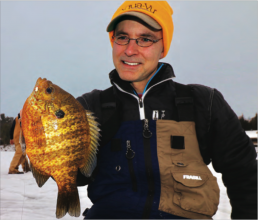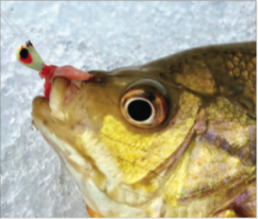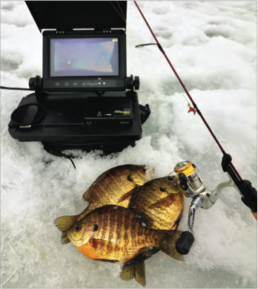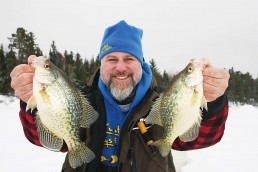Bluegills: Worthy Hardwater Adversaries
SHARE THIS POST
A guide for season-long bluegill success
By Jason Halfen
The high-tech revolution that has reshaped open-water fishing in recent years has also impacted anglers who chase fish through 8-inch holes in the ice. A slow walk through the aisles at your favorite retailer reveals all manner of electronic gadgetry, custom ice rods, thermally-insulated shelters, and scientifically advanced hard and soft baits, all of which are fine-tuned to the exacting requirements of the hardwater specialist.
The dazzling array of contemporary ice fishing equipment can be intimidating, to novice and seasoned ice anglers alike. Yet in its simplest form, ice fishing is no more complicated than cutting a hole, presenting a bait, and fighting a fish. And there is no better quarry on frozen water, particularly for new ice anglers, than the bluegill.
Why? First, bluegills are relatively abundant: when you find some, you likely have found many. That collection of scrappy fighters can rapidly fill an afternoon on the ice, and capture the attention of even the most distracted young angler. Second, bluegills are predictable and easy to find. Their appetites conform to bankers’ hours, too. Third, you don’t need a Ph.D. in fisheries biology to trick bluegills into biting. They are receptive to both live and artificial offerings presented on small jigs or spoons. A modest collection of thoughtfully-selected tackle is all an angler needs to invite a pail of bluegills to a midwinter fish fry.
Location is everything in the bluegill game
Remember those bluegills that hung around the dock all summer, the ones that so willingly entertained the kids? They’re not under the dock anymore, but they haven’t gone far. Especially at first ice, start looking for hardwater bluegills by walking out to the nearest area of thick weed growth. If those weeds are still green beneath the lake’s ice cap, they likely harbor bluegills. For the largest specimens in the area, focus on the deep weed edge, often in 10 to 14 feet of water. In reality, this location is no different from the areas where you chased panfish during the heat of the summer. In fact, the behavior and locations of many species during the dog-days of mid-summer and mid-winter is the same. So, if your database includes a couple of prime July or August bluegill holes, don’t be afraid to visit them again in late January or February.
Oftentimes, near-shore weeds are overrun with tater-tots: juvenile panfish that briefly entertain but ultimately frustrate ice anglers. If this sounds familiar, leave those weedbeds in the rear-view mirror and head for mid-depth flats. Look for those flat 16 to 20 feet deep, between the near-shore weeds and the lake’s primary deep basin. Such soft-bottom flats are often abundant with larvae of aquatic insects that live in the sediment—favored forage. Large schools of quality-sized bluegills often roam these flats, grazing upon the insect life like a herd of sheep munches on mountain pastures. These schools aren’t restricted to a particular depth or closely associated with structure. Rather, they travel to, and remain in, areas with food. Once the bugs are gone, the bluegills leave. Remember that bluegills are highly mobile on the flats. So drill lots of holes and checking until you see what could be bluegills on your fish finder. Multiple sonar returns within 2 or 3 feet of the bottom usually indicates that bluegills are underfoot.
Bluegill tackle, from soup to nuts
Now that you’ve found some bluegills, it’s time to catch a bunch. Since their primary forage is insects and larvae, try a petite presentation, accented with either a live or soft plastic bait. A 4 mm Fiskas tungsten jig dressed with a couple of waxworms or spikes (especially red ones!) is an excellent compact, starter presentation.
Are you enjoying this post?
You can be among the first to get the latest info on where to go, what to use and how to use it!
It mimics one of the bluegill’s favored winter prey, and is always on one of my bluegill rods. Tie that jig to thin monofilament or ice- specific fluorocarbon, 2- to 3-pound test at most, with a double surgeon’s knot or other loop knot. Those knots keep the jig from spinning, an unnatural action that repels fish and can significantly reduce bluegill catch rates. I chase bluegills with ultra-light ice rods, with the 28-inch St. Croix Mojo Ice MIR28UL a good one both for inside the shelter and hole-hopping. Like all good panfish rods, it provides the sensitivity
to detect subtle bites, the action to enjoy scrappy fights and power to handle the occasional largemouth or pike that cruise the mid-depth, bluegill-infested flats.
Difference makers for bluegill wranglers
Bluegills are typically easy to find and receptive biters, but some simple refinements to your presentation brings more to hand.
First, reduce your jig stroke to a subtle shake. This is not the time for large, 1- to 2-foot motions of your jig through the water column. Rather, the best bluegill jig motion is often a simple quiver that you might produce after that third cup of coffee. Keep that quivering offering at the same depth, or just a few inches above, the bluegill returns that you see on your fishfinder. Bites usually follow in short order.
Second, consider an underwater camera to fine-tune your presentation and monitor bluegill moods. A high-definition underwater camera, like the Aqua-Vu HD 700i, makes it easy see which jig motions attract biters and avoid those that send ’gills scurrying back to the weeds.
Finally, recognize that bluegills are often harbingers of things to come. When your red-hot bluegill bite suddenly turns ice-cold, it’s time to prepare for a bass or pike bite. Moreover, a daytime bluegill hotspot often evolves into crappie town as the sun sets. These speckled panfish eat the same food that bluegills do, but usually become more active at dusk and through the night. So, if you’re looking for a place to park that ice house for the weekend, find that mid-depth flat packed with bluegills by day and overrun by crappies after dark.
For many anglers, ice fishing is far more than a simple pastime. For the few brief months when ice caps our favorite lakes, dropping baits through 8-inch holes in the ice is an addiction. It’s a healthy addiction that gets us outside and brings us together with family and friends. For many ice addicts, the bluegill was the gateway fish. Put these timely bluegill tips to use, and you’ll soon appreciate the meaning behind the phrase, “the tug is the drug.”
MWO
Did you enjoy this post?
You can be among the first to get the latest info on where to go, what to use and how to use it!
MWO
We believe being outdoors is good. With more than 1,000 articles each year, MidWest Outdoors magazine is all about sharing outdoor experiences with you—where to go, what to use and how to use it… whether you’re close to home or on that trip of a lifetime.



